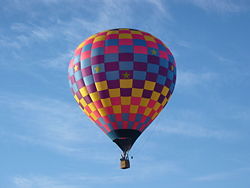Aircraft: Difference between revisions
Jump to navigation
Jump to search
imported>Dan Nachbar m (removed stub designation) |
imported>Dan Nachbar m (added another image) |
||
| Line 1: | Line 1: | ||
[[Image:Hot air balloon in flight.jpg|right|thumb| | [[Image:P51 and f16 in flight.jpg|right|thumb|250px|{{#ifexist:Template:P51 and f16 in flight.jpg/credit|{{P51 and f16 in flight.jpg/credit}}<br/>|}}Airplanes are a type of heavier-than-air aircraft.]] | ||
[[Image:Hot air balloon in flight.jpg|right|thumb|250px|{{#ifexist:Template:Hot air balloon in flight.jpg/credit|{{Hot air balloon in flight.jpg/credit}}<br/>|}}A [[hot air balloon]] is a type of lighter-than-air aircraft.]] | |||
'''Aircraft''' are vehicles capable of sustained flight within the Earth's atmosphere. | '''Aircraft''' are vehicles capable of sustained flight within the Earth's atmosphere. | ||
Revision as of 20:54, 17 November 2007
Aircraft are vehicles capable of sustained flight within the Earth's atmosphere.
Vehicles that travel beyond the Earth's atmosphere, normally defined as 100,000 meters altitude, are called spacecraft.
Aircraft remain aloft using on two basic principles: 1) aerodynamically by pushing air downward or 2) aerostatically by using low density gas.
Most aircraft use aerodynamic lift. These include airplanes and helicopters.
Aircraft that use aerostatic lift include balloons and airships.

